ECU Oldsmobile Achieva 1998 Owner's Manuals
[x] Cancel search | Manufacturer: OLDSMOBILE, Model Year: 1998, Model line: Achieva, Model: Oldsmobile Achieva 1998Pages: 356, PDF Size: 18.04 MB
Page 14 of 356
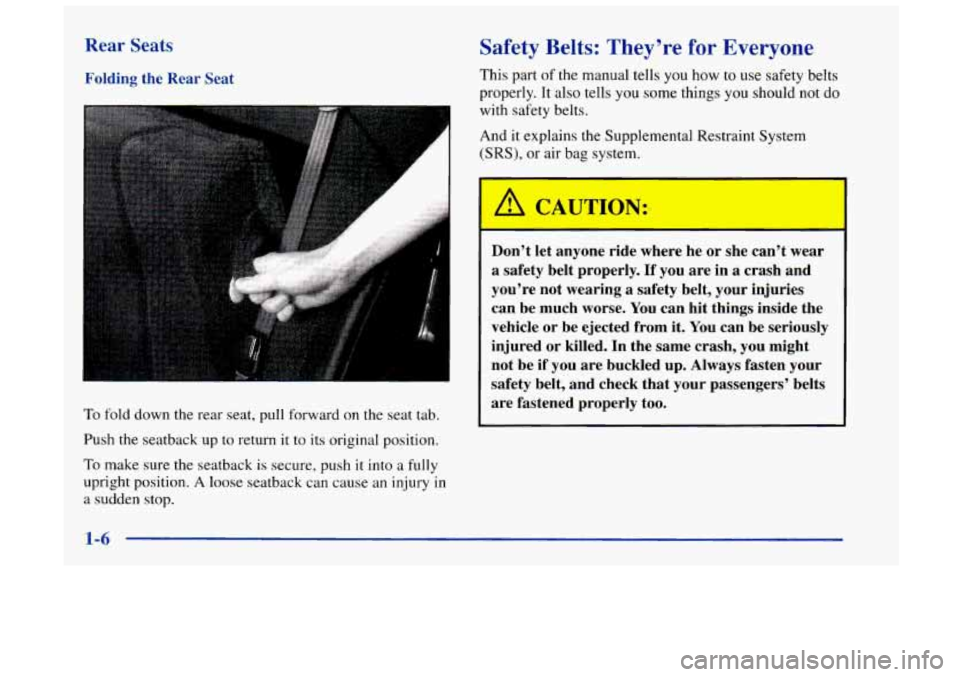
Rear Seats
Folding the Rear Seat
To fold down the rear seat, pull forward on
the seat tab.
Push the seatback up to return
it to its original position.
To make sure the seatback is secure, push it into a fully
upright position. A loose seatback can cause an injury in
a sudden stop.
Safety Belts: They’re for Everyone
This part of the manual tells you how to use safety belts
properly. It also tells you some things you should not
do
with safety belts.
And it explains the Supplemental Restraint System
(SRS), or air bag system.
I A CAUTION: I
Don’t let anyone ride where he or she can’t wear
a safety belt properly. If you are in a crash and
you’re not wearing a safety belt, your injuries can be much worse. You can hit things inside the
vehicle or be ejected from it.
You can be seriously
injured or killed. In the same crash, you might
not be if you are buckled up. Always fasten your
safety belt, and check that your passengers’ belts
are fastened properly too.
1-6
Page 21 of 356
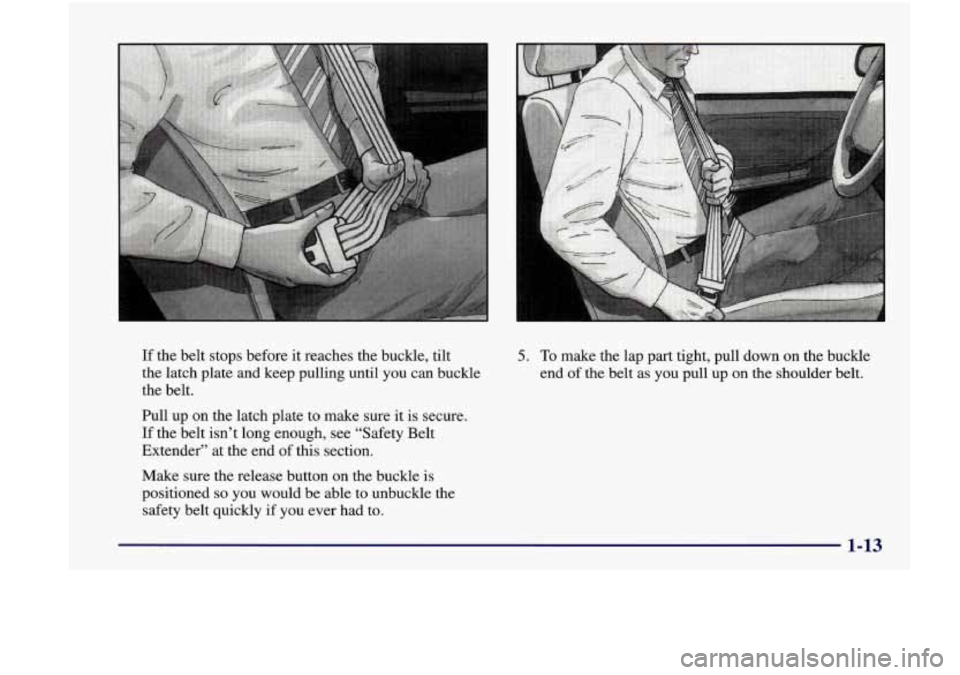
If the belt stops before it reaches the buckle, tilt
the latch plate and keep pulling until you can buckle
the belt. 5. To make the lap part tight, pull down on the buckle
end
of the belt as you pull up on the shoulder belt.
Pull up on the latch plate to make sure it is secure.
If the belt isn’t long enough, see “Safety Belt
Extender” at the end of this section.
Make sure the release button on the buckle is
positioned
so you would be able to unbuckle the
safety belt quickly if you ever had to.
1-13
Page 30 of 356
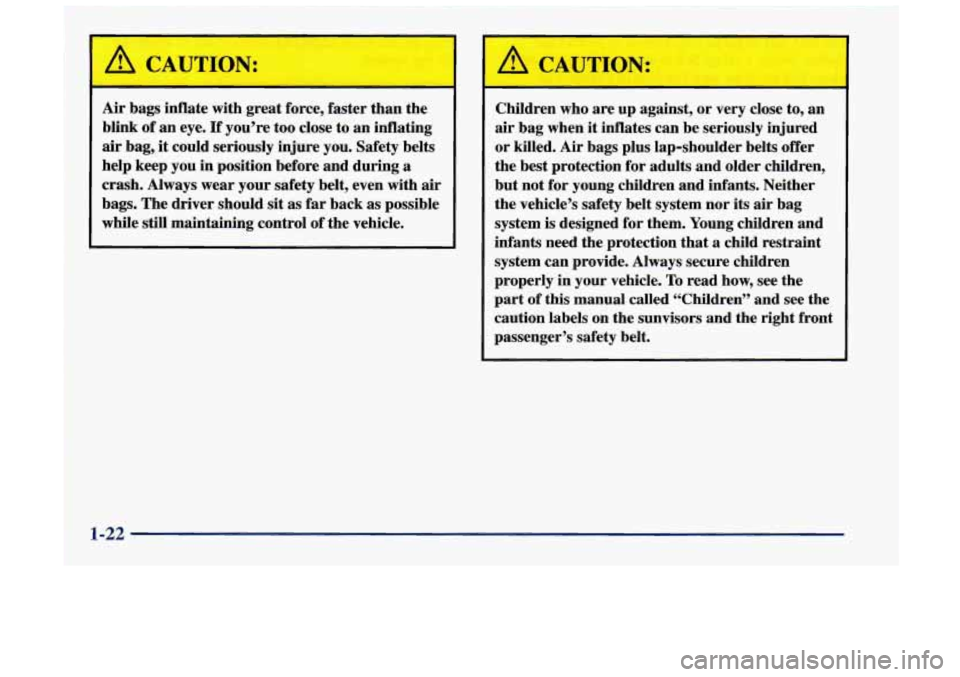
A CAUTION:
Air bags inflate with great force, faster than the
blink of an eye.
If you’re too close to an inflating
air bag, it could seriously injure you. Safety belts
help keep you in position before and during a
crash. Always wear your safety belt, even with air
bags. The driver should sit as far back as possible
while still maintaining control of the vehicle.
~
‘
A CAUTION:
Children who are up against, or very close to, an
air bag when it inflates can be seriously injured
or killed. Air bags plus lap-shoulder belts offer
the best protection for adults and older children,
but not for young children and infants. Neither
the vehicle’s safety belt system nor its air bag
system is designed for them. Young children and
infants need the protection that
a child restraint
system can provide. Always secure children
properly in your vehicle.
To read how, see the
part
of this manual called “Children” and see the
caution labels on the sunvisors and the right front
passenger’s safety belt.
1-22
Page 37 of 356
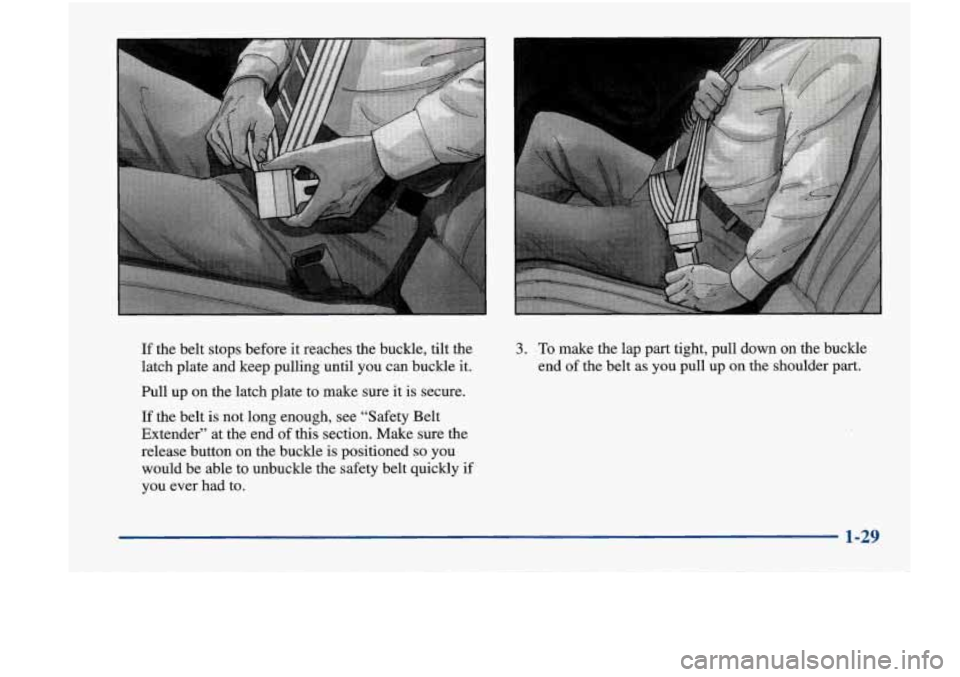
If the belt stops before it reaches the buckle, tilt the
latch plate and keep pulling until you can buckle it.
Pull up on the latch plate
to make sure it is secure.
If the belt is not long enough, see “Safety Belt
Extender” at the end
of this section. Make sure the
release button on the buckle is positioned
so you
would be able to unbuckle the safety belt quickly
if
you ever had to.
3. To make the lap part tight, pull down on the buckle
end of the belt as
you pull up on the shoulder part.
1-29
Page 44 of 356
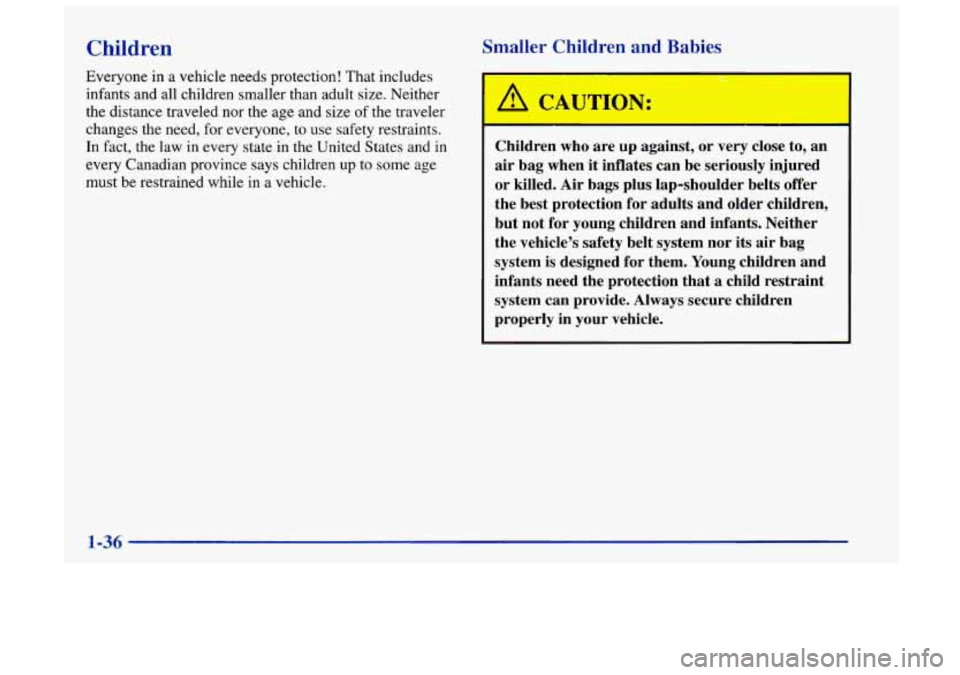
Children
Everyone in a vehicle needs protection! That includes
infants and all children smaller than adult size. Neither
the distance traveled nor the age and size
of the traveler
changes the need, for everyone,
to use safety restraints.
In fact, the law in every state in the United States and in
every Canadian province says children
up to some age
must be restrained while in a vehicle.
Smaller Children and Babies
A 4UTIC X:
Children who are up against, or very close to, an
air bag when it inflates can be seriously injured
or killed. Air bags plus lap-shoulder belts offer
the best protection for adults and older children,
but not for young children and infants. Neither the vehicle’s safety belt system nor its air bag
system is designed for them. Young children and
infants need the protection that
a child restraint
system can provide. Always secure children
properly in your vehicle.
1-36
Page 45 of 356
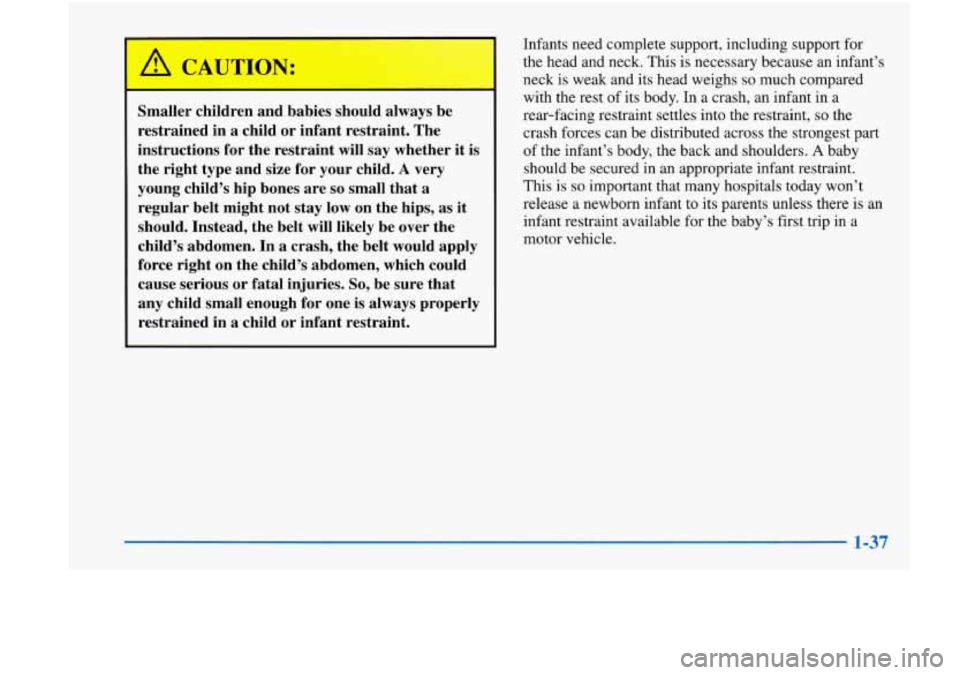
Smaller children and babies should always be
restrained in a child
or infant restraint. The
instructions for the restraint will say whether it is
the right type and size for your child.
A very
young child’s hip bones are
so small that a
regular belt might not stay low on the hips,
as it
should. Instead, the belt will likely be over the
child’s abdomen. In
a crash, the belt would apply
force right on the child’s abdomen, which could
cause serious or fatal injuries.
So, be sure that
any child small enough for one
is always properly
restrained in
a child or infant restraint.
Infants need complete support, including support for
the head and neck. This is necessary because an infant’s
neck is weak and its head weighs
so much compared
with the rest of its body. In a crash, an infant in a
rear-facing restraint settles into the restraint,
so the
crash forces can be distributed across the strongest
part
of the infant’s body, the back and shoulders. A baby
should be secured in an appropriate infant restraint.
This is
so important that many hospitals today won’t
release a newborn infant to its parents unless there is an
infant restraint available for the baby’s first trip in a
motor vehicle.
1-37
Page 46 of 356
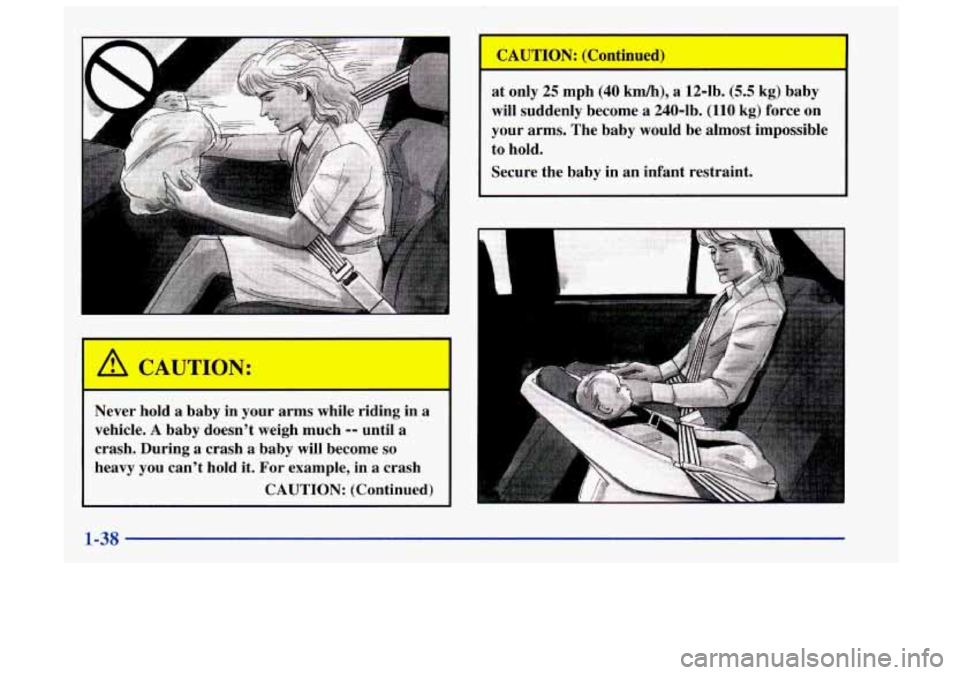
F
Never hold a baby in your arms while riding in a
vehicle. A baby doesn’t weigh much -- until a
crash. During a crash a baby will become so
heavy you can’t hold it. For example, in a crash
CAUTION: (Continued) at
only 25 mph (40
km/h), a 124b. (5.5 kg) baby
will suddenly become
a 240-lb. (110 kg) force on
your arms. The baby would be almost impossible
to hold.
Secure the baby in an infant restraint.
I
1-38
Page 48 of 356
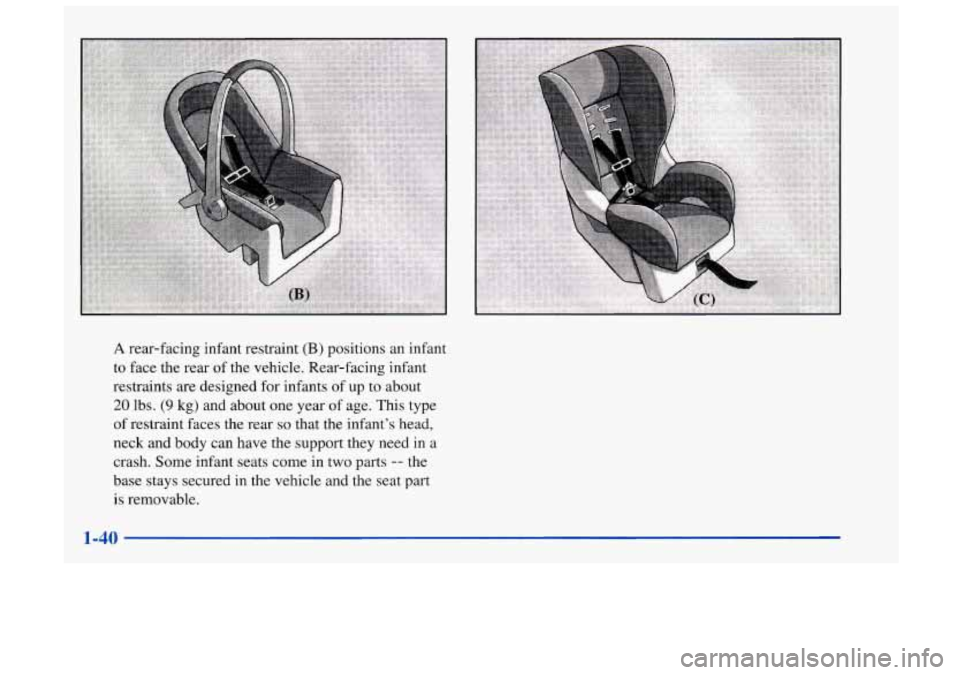
A rear-facing infant restraint (B) positions an infant
to face the rear of the vehicle. Rear-facing infant
restraints are designed for infants of up to about
20 lbs. (9 kg) and about one year of age. This type
of restraint faces the rear so that the infant’s head,
neck and body can have the support they need in a
crash. Some infant seats come in two parts
-- the
base stays secured in the vehicle and the seat part
is removable.
1-40
Page 51 of 356
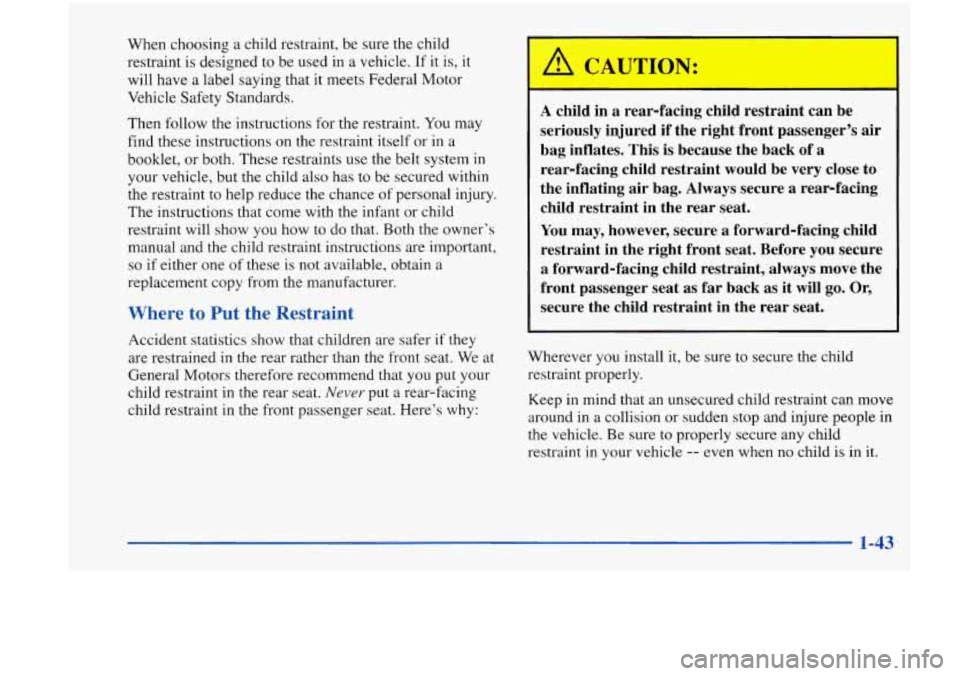
When choosing a child restraint, be sure the child
restraint is designed to be used in a vehicle. If it is, it
will have a label saying that it meets Federal Motor
Vehicle Safety Standards.
Then follow the instructions for the restraint. You may
find these instructions on the restraint itself or in a
booklet, or both. These restraints use the belt system
in
your vehicle, but the child also has to be secured within
the restraint to help reduce the chance
of personal injury.
The instructions that come with the infant or child
restraint will show you how to do that. Both the owner’s
manual and the child restraint instructions are important,
so if either one of these is not available, obtain a
replacement copy from the manufacturer.
Where to Put the Restraint
Accident statistics show that children are safer if they
are restrained
in the rear rather than the front seat. We at
General Motors therefore recommend that you put your
child restraint in the rear seat.
Never put a rear-facing
child restraint in the front passenger seat. Here’s why:
’4 CAUTION:
A child in a rear-facing child restraint can be
seriously injured if the right front passenger’s air
bag inflates. This is because the back of
a
rear-facing child restraint would be very close to
the inflating air bag. Always secure a rear-facing
child restraint in the rear seat.
You may, however, secure
a forward-facing child
restraint in the right front seat. Before you secure
a forward-facing child restraint, always move the
front passenger seat as
far back as it will go. Or,
secure the child restraint in the rear seat.
Wherever you install it, be sure to secure the child
restraint properly.
Keep
in mind that an unsecured child restraint can move
around in a collision or sudden stop and injure people in
the vehicle. Be sure to properly secure any child
restraint
in your vehicle -- even when no child is in it.
1-43
Page 52 of 356
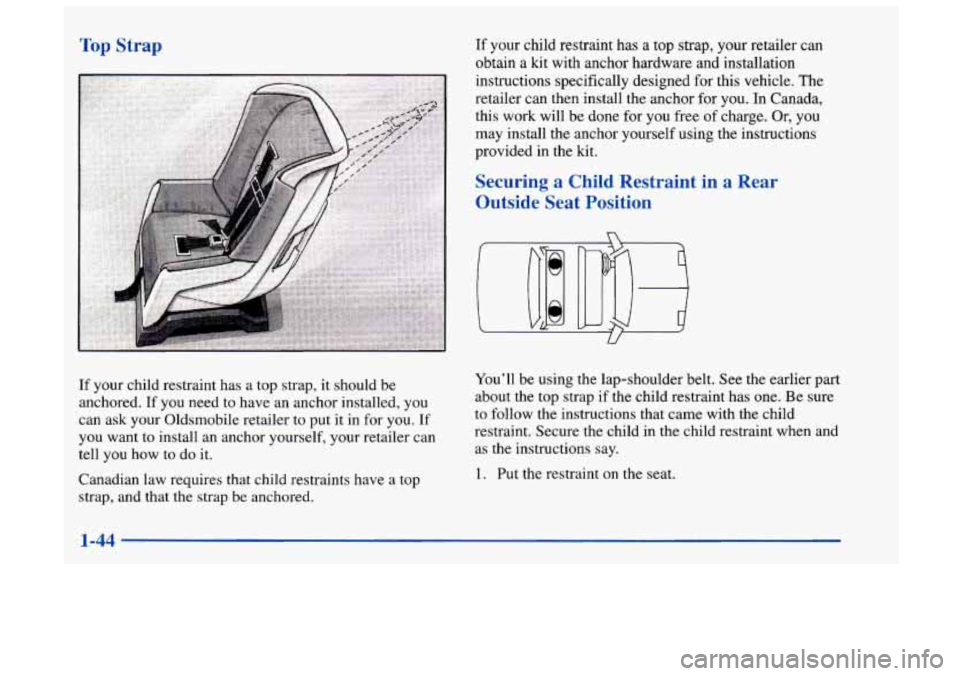
Top Strap
If your child restraint has a top strap, it should be
anchored. If you need to have an anchor installed, you
can ask your Oldsmobile retailer to put it in for you.
If
you want to install an anchor yourself, your retailer can
tell you how
to do it.
Canadian law requires that child restraints have a top
strap, and that the strap be anchored. If
your child restraint has
a top strap, your retailer can
obtain
a kit with anchor hardware and installation
instructions specifically designed for
this vehicle. The
retailer can then install the anchor for you. In Canada,
this work will be done for you free
of charge. Or, you
may install the anchor yourself using the instructions
provided in the kit.
Securing a Child Restraint in a Rear
Outside Seat Position
U
You’ll be using the lap-shoulder belt. See the earlier part
about the top strap if the child restraint has one. Be sure
to follow the instructions that came with the child
restraint. Secure the child in the child restraint when and
as the instructions say.
1. Put the restraint on the seat.
1-44